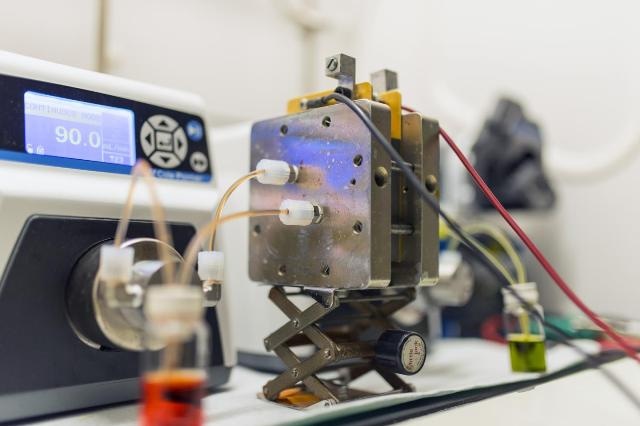Jul 19 2016
A new molecule that is capable of safely storing electricity from irregular sources, such as wind and solar power, has been found by researchers at Harvard. The vitamin B2-inspired organic molecule has high performance rates and can store the energy in large batteries.
 A new class of high-performing organic molecules, inspired by vitamin B2, that can safely store electricity from intermittent energy sources like solar and wind power in flaw batteries, like the one above. (Credit: Kaixiang Lin/Harvard University)
A new class of high-performing organic molecules, inspired by vitamin B2, that can safely store electricity from intermittent energy sources like solar and wind power in flaw batteries, like the one above. (Credit: Kaixiang Lin/Harvard University)
In previous research, the researchers had developed a high-capacity flow battery that used the food addictive ferrocyanide and the organic molecules, quinones to store energy. This study led to the development of the first-ever non-corrosive, non-toxic, high-performance, non-flammable chemicals that are inexpensive. These chemicals can make large-scale storage of electricity not only possible but also affordable.
Though the versatile quinones can make great flow batteries, the researchers at Harvard have been trying to find other organic molecules that can be more effective. However, organic molecules with versatility similar to quinones have been difficult.
Now, after considering about a million different quinones, we have developed a new class of battery electrolyte material that expands the possibilities of what we can do. Its simple synthesis means it should be manufacturable on a large scale at a very low cost, which is an important goal of this project.
Kaixiang Lin, Ph.D. Student, Harvard
Flow Battery
The new study is featured in Nature Energy.
Flow batteries store energy in the form of solutions, in external tanks. Depending upon the size of the tank the amount of energy stored also differs. Michael J. Aziz, the Gene and Tracy Sykes Professor of Materials and Energy Technologies at the Harvard John A. Paulson School of Engineering and Applied Sciences (SEAS), Roy Gordon, the Thomas Dudley Cabot Professor of Chemistry and Professor of Materials Science, Alán Aspuru-Guzik, Professor of Chemistry came together with their Harvard team in 2014 to use quinones, molecules that store energy in animals and plants, instead of metal ions that are used as the standard battery electrolyte materials in acidic electrolytes. The next year, the team developed a quinone that had the potential to work with a food addictive, in alkaline solutions.
This latest study has been inspired by vitamin B2, a vitamin that helps storing energy obtained from food in the body. B2 unlike quinone used nitrogen atoms in place of oxygen atoms to pick up and release electrons.
With only a couple of tweaks to the original B2 molecule, this new group of molecules becomes a good candidate for alkaline flow batteries. They have high stability and solubility and provide high battery voltage and storage capacity. Because vitamins are remarkably easy to make, this molecule could be manufactured on a large scale at a very low cost.
Micheal J. Aziz, Professor, Harvard
“We designed these molecules to suit the needs of our battery, but really it was nature that hinted at this way to store energy,” said Gordon, co-senior author of the paper. “Nature came up with similar molecules that are very important in storing energy in our bodies.”
Further research to develop durable, cost-effective flow battery that has high performance rates will be conducted by the team, which will continue its study of quinones.
To commercialize the new chemistries, the Harvard’s Office of Technology Development has come together with the team to contact various companies and to better face the ever-changing, complex energy storage market.
Lin, Aziz, Gordon, Aspuru-Guzik, Rafael Gómez-Bombarelli, Eugene S. Beh, Liuchuan Tong, Qing Chen, and Alvaro Valle.
The study has been supported by the Massachusetts Clean Energy Technology Center, the National Science Foundation and the Department of Energy's Advanced Research Projects Agency-Energy.